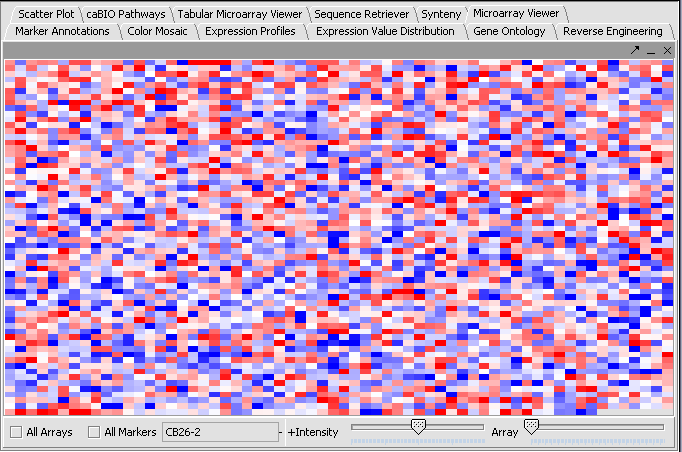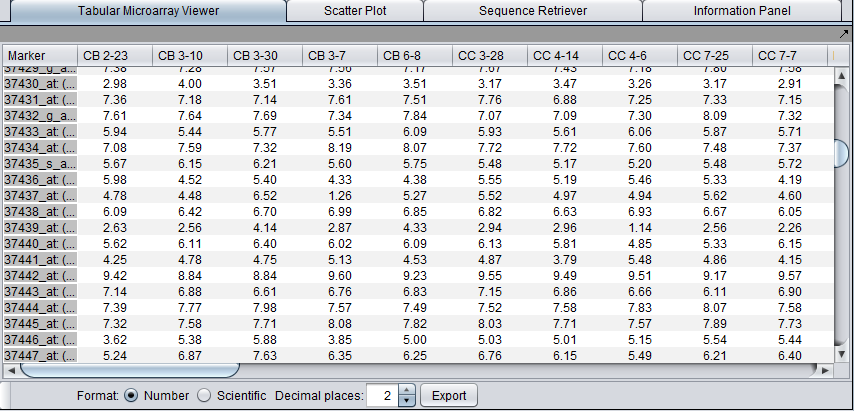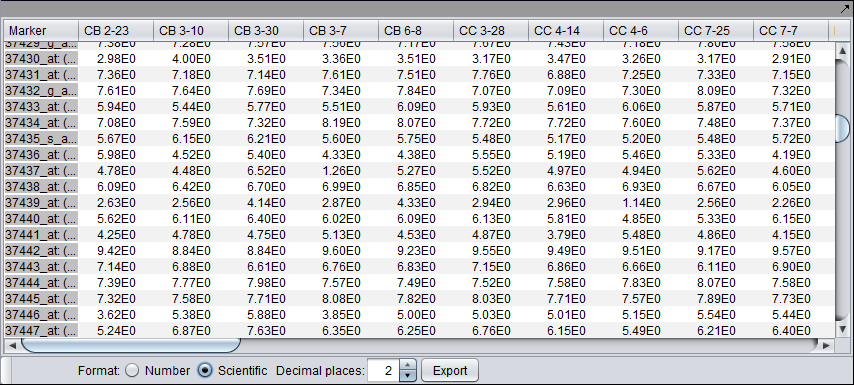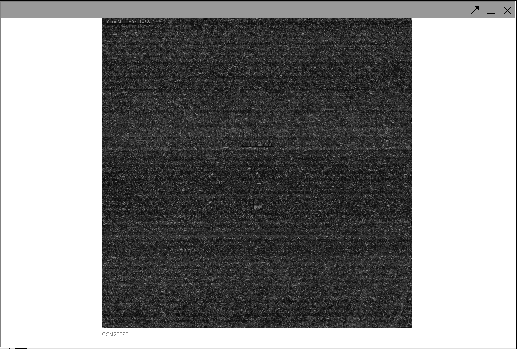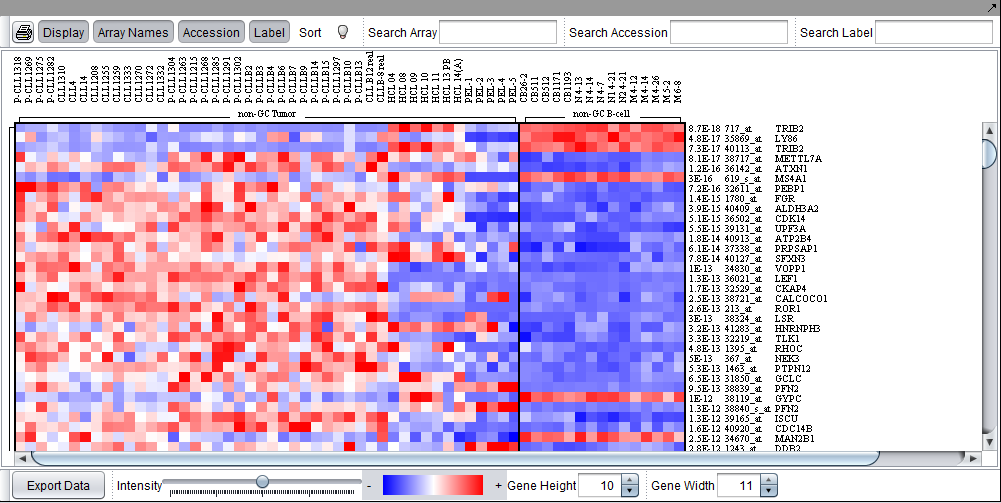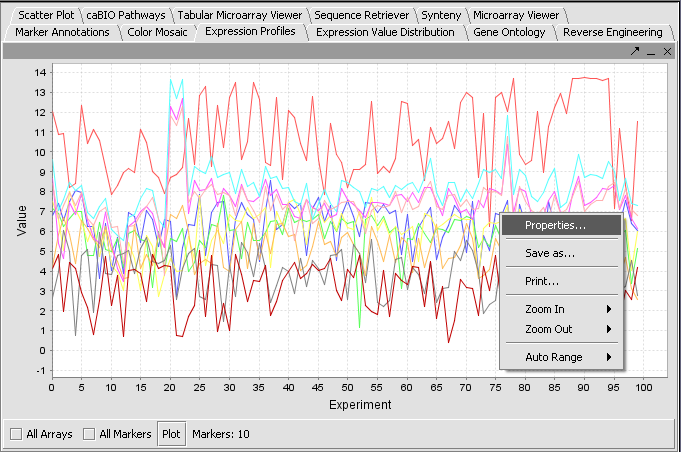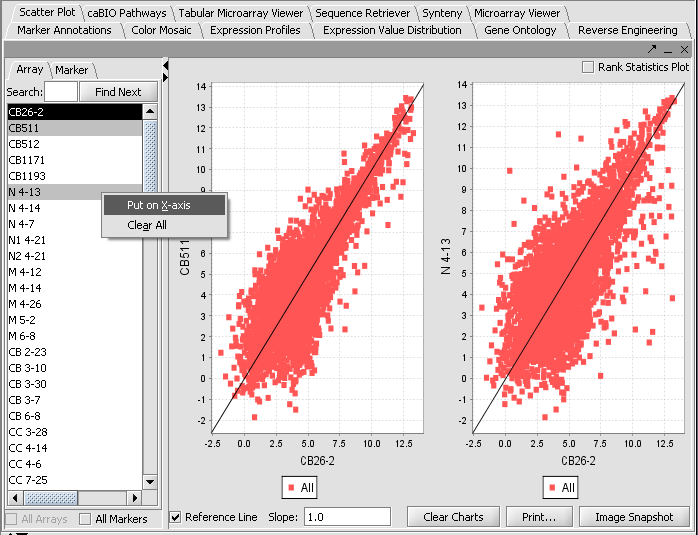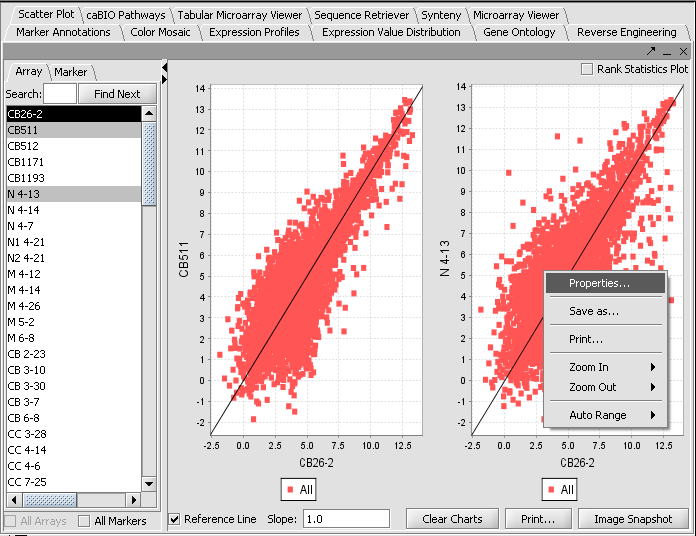Microarray Dataset Viewers
|
Home | Quick Start | Basics | Menu Bar | Preferences | Component Configuration Manager | Workspace | Information Panel | Local Data Files | File Formats | caArray | Array Sets | Marker Sets | Microarray Dataset Viewers | Filtering | Normalization | Tutorial Data | geWorkbench-web Tutorials |
Analysis Framework | ANOVA | ARACNe | BLAST | Cellular Networks KnowledgeBase | CeRNA/Hermes Query | Classification (KNN, WV) | Color Mosaic | Consensus Clustering | Cytoscape | Cupid | DeMAND | Expression Value Distribution | Fold-Change | Gene Ontology Term Analysis | Gene Ontology Viewer | GenomeSpace | genSpace | Grid Services | GSEA | Hierarchical Clustering | IDEA | Jmol | K-Means Clustering | LINCS Query | Marker Annotations | MarkUs | Master Regulator Analysis | (MRA-FET Method) | (MRA-MARINa Method) | MatrixREDUCE | MINDy | Pattern Discovery | PCA | Promoter Analysis | Pudge | SAM | Sequence Retriever | SkyBase | SkyLine | SOM | SVM | T-Test | Viper Analysis | Volcano Plot |
Contents
Outline
In this section, various tools for visualizing microarray expression data will be introduced. Available options for each component will be depicted.
The visualizers displayed here are:
- Microarray Viewer
- Tabular Microarray Viewer
- CEL file image viewer
- Color Mosaic
- Expression Profiles
- Scatter Plot
The options for several of the components are set from the application toolbar preferences menu, which will also be explained.
Overview
Visualization tools provide a view of the microarray datasets under investigation and can be used e.g. for ascertaining the quality of the data. Activating marker and array/phenotype sets (Tutorial - Data Subsets) can be used to restrict the number of markers/arrays displayed. The images created can be saved and exported. A more detailed description of how to manipulate visualization components is given in the online help.
Microarray Viewer
Used to inspect data from each separate microarray using the Array scroll bar. Note that the markers (probes or probesets) are displayed in the order they appear in the dataset, and the image is not a physical representation of the microarray layout. The image can be saved into the Project Folders component under its parent dataset by right-clicking and selecting Save Image.
The viewing preference shown here is the "relative" display mode. See Preferences for switching between relative and absolute display modes.
Tabular Microarray Viewer
Presents the numerical values of the expression measurements in a table format. One row is created per individual marker/probe and one column per microarray.
- Format
- Number - display numbers in regular notation.
- Scientific - display numbers in scientific notation.
- Decimal Places - choose how many places after the decimal to display. Numbers are rounded to the specified precision.
The Tabular Microarray Viewer using regular number format:
The Tabular Microarray Viewer using scientific format:
CEL file image viewer
The Affymetrix CEL file contains a single intensity value calculated for each probe on the chip. It is derived from the raw image (.dat) file. Individual Affymetrix CEL files can be read into geWorkbench. They are displayed in the CEL file image viewer. This can be used to check for obvious problems such as fingerprints or uneven drying which could affect data quality. Note that is file is not an exact image of the chip, but a reconstructed image at the probe level. The CEL file image viewer component is simply a viewer, it does not permit any operations on the image.
Color Mosaic
Heat map for microarray expression data, organized by phenotypic or gene groupings. If sets of markers or arrays have been activated, they will be displayed beside or above the color mosaic.
Display Controls
- Display - Activate the Color Mosaic display.
- Array Names - Display array names above the columns of the color mosaic.
- Accession - Display the accession number (e.g. Affymetrix probeset name) to the right of each row in the color mosaic.
- Label - Display the gene name (if available) to the right of each row in the color mosaic.
- Sort -
- lightbulb - When activated, hover text over any cell in the color mosaic will give the following information:
- Chip - the name of the array
- Marker - the marker name/accession number (e.g. Affymetrix probeset id).
- Signal - The value of the signal in the dataset for the marker/array pair.
Search Controls
- Search features - Array names, accession numbers, and labels can be searched for using their respective search fields. The search fields are active only when the corresponding feature has been selected for display using the buttons described above. In each case, the next matching feature will be highlighted in blue. Hitting return again in the search box will advance the highlight to the next match.
- Search Array - Search array names.
- Search Accession - Search accession numbers.
- Search Label - Search marker names.
- Clear Search - clear the search result hightlights.
Preferences
Color Preferences - See Preferences for switching between absolute and relative color schemes.
Expression Profiles
For each active marker (default is all), a line showing the expression value vs array is graphed. Each marker is displayed with a separate color line. The Plot button must be pushed to draw the display. If a subset of markers has been activated, the number active is shown adjacent to the Markers label. Right-click options are shown.
Scatter Plot
A pairwise (array vs. array and marker vs. marker) comparison and plotting of expression values. The first marker selected serves as the x-axis reference, shown with a dark background; this can also be set by right-clicking and selecting the x-axis marker as shown). Subsequent arrays selected are plotted against this reference in different sub-images. Up to six sub-images can be created. Right-click options are shown in the second picture.
Preparation
Load a microarray dataset, for example the file webmatrix_quantile_log2_dev1.2_mv0.exp that is included with the geWorkbench tutorial data Download.
Viewing a dataset
- In the View Area at the top-right section of the interface, select any viewer described above, for example the Microarray Viewer component.
- On several of the components, the All Markers and All Arrays checkboxes can be used to override the effects of activated sets, should they be in use. When no sets are activated, all markers or arrays will be used.
